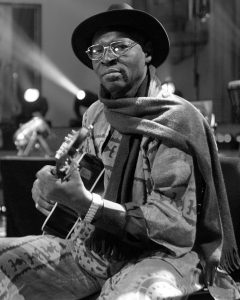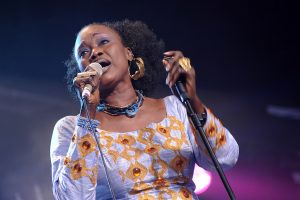1.23: African Popular Music
- Page ID
- 168935
\( \newcommand{\vecs}[1]{\overset { \scriptstyle \rightharpoonup} {\mathbf{#1}} } \)
\( \newcommand{\vecd}[1]{\overset{-\!-\!\rightharpoonup}{\vphantom{a}\smash {#1}}} \)
\( \newcommand{\dsum}{\displaystyle\sum\limits} \)
\( \newcommand{\dint}{\displaystyle\int\limits} \)
\( \newcommand{\dlim}{\displaystyle\lim\limits} \)
\( \newcommand{\id}{\mathrm{id}}\) \( \newcommand{\Span}{\mathrm{span}}\)
( \newcommand{\kernel}{\mathrm{null}\,}\) \( \newcommand{\range}{\mathrm{range}\,}\)
\( \newcommand{\RealPart}{\mathrm{Re}}\) \( \newcommand{\ImaginaryPart}{\mathrm{Im}}\)
\( \newcommand{\Argument}{\mathrm{Arg}}\) \( \newcommand{\norm}[1]{\| #1 \|}\)
\( \newcommand{\inner}[2]{\langle #1, #2 \rangle}\)
\( \newcommand{\Span}{\mathrm{span}}\)
\( \newcommand{\id}{\mathrm{id}}\)
\( \newcommand{\Span}{\mathrm{span}}\)
\( \newcommand{\kernel}{\mathrm{null}\,}\)
\( \newcommand{\range}{\mathrm{range}\,}\)
\( \newcommand{\RealPart}{\mathrm{Re}}\)
\( \newcommand{\ImaginaryPart}{\mathrm{Im}}\)
\( \newcommand{\Argument}{\mathrm{Arg}}\)
\( \newcommand{\norm}[1]{\| #1 \|}\)
\( \newcommand{\inner}[2]{\langle #1, #2 \rangle}\)
\( \newcommand{\Span}{\mathrm{span}}\) \( \newcommand{\AA}{\unicode[.8,0]{x212B}}\)
\( \newcommand{\vectorA}[1]{\vec{#1}} % arrow\)
\( \newcommand{\vectorAt}[1]{\vec{\text{#1}}} % arrow\)
\( \newcommand{\vectorB}[1]{\overset { \scriptstyle \rightharpoonup} {\mathbf{#1}} } \)
\( \newcommand{\vectorC}[1]{\textbf{#1}} \)
\( \newcommand{\vectorD}[1]{\overrightarrow{#1}} \)
\( \newcommand{\vectorDt}[1]{\overrightarrow{\text{#1}}} \)
\( \newcommand{\vectE}[1]{\overset{-\!-\!\rightharpoonup}{\vphantom{a}\smash{\mathbf {#1}}}} \)
\( \newcommand{\vecs}[1]{\overset { \scriptstyle \rightharpoonup} {\mathbf{#1}} } \)
\( \newcommand{\vecd}[1]{\overset{-\!-\!\rightharpoonup}{\vphantom{a}\smash {#1}}} \)
\(\newcommand{\avec}{\mathbf a}\) \(\newcommand{\bvec}{\mathbf b}\) \(\newcommand{\cvec}{\mathbf c}\) \(\newcommand{\dvec}{\mathbf d}\) \(\newcommand{\dtil}{\widetilde{\mathbf d}}\) \(\newcommand{\evec}{\mathbf e}\) \(\newcommand{\fvec}{\mathbf f}\) \(\newcommand{\nvec}{\mathbf n}\) \(\newcommand{\pvec}{\mathbf p}\) \(\newcommand{\qvec}{\mathbf q}\) \(\newcommand{\svec}{\mathbf s}\) \(\newcommand{\tvec}{\mathbf t}\) \(\newcommand{\uvec}{\mathbf u}\) \(\newcommand{\vvec}{\mathbf v}\) \(\newcommand{\wvec}{\mathbf w}\) \(\newcommand{\xvec}{\mathbf x}\) \(\newcommand{\yvec}{\mathbf y}\) \(\newcommand{\zvec}{\mathbf z}\) \(\newcommand{\rvec}{\mathbf r}\) \(\newcommand{\mvec}{\mathbf m}\) \(\newcommand{\zerovec}{\mathbf 0}\) \(\newcommand{\onevec}{\mathbf 1}\) \(\newcommand{\real}{\mathbb R}\) \(\newcommand{\twovec}[2]{\left[\begin{array}{r}#1 \\ #2 \end{array}\right]}\) \(\newcommand{\ctwovec}[2]{\left[\begin{array}{c}#1 \\ #2 \end{array}\right]}\) \(\newcommand{\threevec}[3]{\left[\begin{array}{r}#1 \\ #2 \\ #3 \end{array}\right]}\) \(\newcommand{\cthreevec}[3]{\left[\begin{array}{c}#1 \\ #2 \\ #3 \end{array}\right]}\) \(\newcommand{\fourvec}[4]{\left[\begin{array}{r}#1 \\ #2 \\ #3 \\ #4 \end{array}\right]}\) \(\newcommand{\cfourvec}[4]{\left[\begin{array}{c}#1 \\ #2 \\ #3 \\ #4 \end{array}\right]}\) \(\newcommand{\fivevec}[5]{\left[\begin{array}{r}#1 \\ #2 \\ #3 \\ #4 \\ #5 \\ \end{array}\right]}\) \(\newcommand{\cfivevec}[5]{\left[\begin{array}{c}#1 \\ #2 \\ #3 \\ #4 \\ #5 \\ \end{array}\right]}\) \(\newcommand{\mattwo}[4]{\left[\begin{array}{rr}#1 \amp #2 \\ #3 \amp #4 \\ \end{array}\right]}\) \(\newcommand{\laspan}[1]{\text{Span}\{#1\}}\) \(\newcommand{\bcal}{\cal B}\) \(\newcommand{\ccal}{\cal C}\) \(\newcommand{\scal}{\cal S}\) \(\newcommand{\wcal}{\cal W}\) \(\newcommand{\ecal}{\cal E}\) \(\newcommand{\coords}[2]{\left\{#1\right\}_{#2}}\) \(\newcommand{\gray}[1]{\color{gray}{#1}}\) \(\newcommand{\lgray}[1]{\color{lightgray}{#1}}\) \(\newcommand{\rank}{\operatorname{rank}}\) \(\newcommand{\row}{\text{Row}}\) \(\newcommand{\col}{\text{Col}}\) \(\renewcommand{\row}{\text{Row}}\) \(\newcommand{\nul}{\text{Nul}}\) \(\newcommand{\var}{\text{Var}}\) \(\newcommand{\corr}{\text{corr}}\) \(\newcommand{\len}[1]{\left|#1\right|}\) \(\newcommand{\bbar}{\overline{\bvec}}\) \(\newcommand{\bhat}{\widehat{\bvec}}\) \(\newcommand{\bperp}{\bvec^\perp}\) \(\newcommand{\xhat}{\widehat{\xvec}}\) \(\newcommand{\vhat}{\widehat{\vvec}}\) \(\newcommand{\uhat}{\widehat{\uvec}}\) \(\newcommand{\what}{\widehat{\wvec}}\) \(\newcommand{\Sighat}{\widehat{\Sigma}}\) \(\newcommand{\lt}{<}\) \(\newcommand{\gt}{>}\) \(\newcommand{\amp}{&}\) \(\definecolor{fillinmathshade}{gray}{0.9}\)The popular music of Africa is greatly varied from region to region and culture to culture. Though most African popular music is influenced, to some degree, by western popular music and Afro Cuban music in one way or another, the traditional music of Africa plays the most important part in this music. North African music is the result of a fusion of the traditional music of Islam and the Middle East with cultures of Africa and the Mediterranean. Much of it incorporates the folk instruments, musical scales, and rhythms of North Africa with elements of western popular music. The music of West Africa is highly distinctive with its use of highly complex rhythms and melodies. This style is known as Afropop. West African popular songs often incorporate a single chord vamp over complex rhythms, much like funk music. Central African popular music took the influence of Cuban music in the mid-20th century with the dance music called Rumba. The guitar-driven Soukous style emerged from this fusion. East Africa is somewhat related to North Africa due to the influence of the middle east and Islamic culture in the region. The traditional folk music is a very important element in the popular music of countries such as Ethiopia. South African popular music offers a blend of Western and African styles. The music of Zimbabwe is perhaps the most unique, and uses the characteristic sound of the Mbira, a hand held percussion instrument that involves playing metal keys with the thumbs. This day’s lecture will touch on a few of these regions with a special focus on the popular music of West Africa.
North Africa: Khaled

Khaled (Born 1960) is a popular Algerian Rai singer. Rai is a folk music featuring a mixture of traditional Bedouin shepherd music and French, Spanish, African, and Arabic musical forms. Rai has become a form of popular music as well, incorporating the traditional with elements of western popular music. Since the 1990s, funk, hip hop, and club dance music have been incorporated into Rai.
Khaled was the first Rai performer to gain international success, beginning in the 1980s. With his album “Khaled” in 1992 he began to incorporate western sounds into his music, working with an American producer. The sound combined traditional North African instruments with western beats and rhythmic patterns created with computers and keyboards. The popular song “Didi” (1992) is very western-influenced, featuring both traditional North African and western instruments and melodic elements with a rock style beat.
Listening Examples 23.1
“Bakhta” by Khaled displays more North African folk influences including traditional instruments, scales and rhythmic accents. Vocally, he explores a more folk-influenced guttural sound. These sounds set the music apart from standard western popular music. There are elements that can be related back to the music Western listeners are familiar with. First, the vocal phrases themselves are concise and serve as melodic “hooks” that stick to one’s memory relatively quickly. Second, western song forms apparent in the song, as there are two distinct sections that alternate throughout the song.
West Africa
The music of West Africa is highly distinctive with its use of highly complex rhythms and melodies. West African popular songs often incorporate a single-chord vamp over dense layers of multiple rhythmic patterns, much like funk music. The melodies, whether vocal or instrumental, are often much longer and more complex than standard western pop melodies, sounding improvised but usually thoroughly composed and expertly executed. This sound is quite close to the style of African-American gospel singing. In fact, many West African melodies can evoke, in the ear of the western listener, reminders of the blues or gospel, the direct descendants of African music. Harmony (chord progressions) are not emphasized as much, usually incorporating a single chord or occasionally a second or third implied chord. This serves to heighten attention to the already complex rhythms and melodies as complex chord changes could distract from the other elements.
Exercise 23.1
Read through the article, “Popular Music in Africa” by Edna M. Smith. It’s an older article with certain dated information such as the fact that in 1962 there weren’t very many pianos in the bands of West Africa or that the guitarists at that time were unaccustomed to the chords of American jazz. It is also written by an author from a western classical musical standpoint, containing some subjective/judgmental comments on popular music in general. It is, however, interesting from a historical standpoint, but most importantly, the article describes the blending of certain western styles with traditional African music. Pay special attention to the descriptions of what western musical characteristics were being used by the African musicians, and don’t worry about certain musical terms that you haven’t learned.
King Sunny Ade

King Sunny Adé – (born 1946) Is a performer of Nigerian Yoruba Juju music. The music of the Yoruba people is characterized by complex layers of rhythms, and important element in Juju music. Juju music is derived from traditional Yoruba percussion, and since the mid 20th century includes western electric instruments.
The performances of King Sunny Ade are characterized by his elaborate dance steps and his guitar skills. A wide variety of instruments are found in the music including traditional percussion such as talking drums, and western instruments such as electric guitar, pedal steel guitar, and synthesizers.
Afro Beat – Fela Kuti
Fela Kuti – (1938-1997) Was a Nigerian composer, singer, and multi-instrumentalist who was the primary creator of Afro beat. In addition to music, Kuti was a human rights activist and important figure in Nigerian politics. Kuti studied music in London, England and began combining African highlife music and jazz. Afro beat is
characterized by use of call and response, complex interacting rhythms (multiple rhythmic layers), and long, slow developing music. The use of horn sections and multiple guitars add to the density and complexity of the music.
He formed a group in the late 1960s that began playing Afro beat By the early 1970s his music used social topics for the basis of his lyrics. He was endangered at many points in his life for his music and his politics. He died in 1997 and his funeral was attended by over one million people at the site of his former compound.
Ali Farka Toure

Ali Farka Toure – (1939-2006) Was a Malian guitarist, vocalist, and songwriter whose music represented a blend of traditional African music and American blues. His unique guitar style marks him as an influential guitarist on African popular music. He became well known as one of the first African blues musicians to gain popularity throughout the continent.
The music of Ali Farka Toure blended the traditional west African rhythms and vocal stylings with blues-influenced guitar lines. When listening to the recording in Ch. 23 Listening Examples, compare the guitar style of Toure with the styles of blues guitarists such as T-Bone Walker and B.B. King, noting similarities and differences. His son, Vieux Farka Toure continues to perform and develop the musical style pioneered by his father.
Oumou Sangare

Oumou Sangare (Born 1968) Is a Grammy award winning Malian singer and composer who performs Wassoulou music. Wassoulou is primarily sung by female singers, and lyrically often addresses woman’s rights issues in Africa. Wassoulou music often features call-and-response, passionate vocals, a mixture of traditional instruments such as the Kora, single chord vamps, complex rhythms, and complex melodies.
Her band is a mix of Africa and West, using traditional percussion, a Kora, and Ngoni (a small bowed string instrument) and western instruments such as flute, drums, and electric guitar and bass. In this sense it bears resemblance in some ways to the Afro Pop of Fela Kuti. Sangare’s voice is incredibly powerful, reminiscent of the singers of classic blues like Bessie Smith. In addition to her music, she is an advocate for women’s rights.
Listening Examples 23.2
King Sunny Ade:
Fela Kuti: The song below, “Original Sufferhead”, explores in it’s lyrics the topic of Western countries providing aid to people suffering in Africa even though the continent itself is fertile and full of riches which are largely owned by western corporations and ‘developed nations’. Musically, “Original Sufferhead” is composed in a similar way to the music of James Brown and other American funk performers. The music contains a simple groove over which many layers of rhythms (polyrhythm) interact to create a complex web of sound. Here is “Original Sufferhead: Part 2.”
Ali Farka Toure:
- “Ketine”
- Ali Farka Toure live on acoustic guitar with Kora player Toumani Diabate
- Ali Farka Toure live on electric guitar
Oumou Sangare: Notice in the performance by Oumou Sangare below how the vocal melodies are lengthy and complex. They don’t contain short hooks that are found in many Western pop songs. Also notice the complex interaction between all the instruments; each has a defined role and adds to the overall musical texture. The individual parts within the texture are often repetitive or simple, but, as in funk music, each part contributes to an overall texture that is quite complex.
South Africa: Mbaqanga
Mbaqanga is a style of popular music that developed in the country of South Africa. The style features a blend of western popular music and African folk music. Specifically, it features a blend of South African vocal styles and western instruments such as electric guitars and drum sets. Minimal chord progressions inspired by western pop music are often used to support the full, complex vocal harmonies without overshadowing them. The Makgona Tsohle Band is noted for inventing the instrumental style of Mbaqanga.
One of the earliest and most influential groups performing Mbaqanga was Mahlathini and the Mahotella Queens. The group formed in 1964 and was active into the 1970s until members drifted into other areas. In the late 1980s the group reunited due to the success of Paul Simon’s Graceland, an album that combined Simon’s folk music with South African music, particularly Mbaqanga, and brought a new interest from western listeners to “world” music.
The group was comprised of three essential, distinctive elements consisting of Mahlathini, the male lead vocalist who sang in a guttural, deep-voiced style known as “groaning”; The Mahotella Queens, female vocalists who sang in rich, complex harmony; and The Makgona Tsolhle Band, an instrumental group which used western instruments such as electric guitar, saxophone, and drum sets.
Listening Examples 23.3
Maholtini and the Mahotella Queens: “Jabulani Mabungu”
Mbira and Zimbabwe

The mbira (also known as “thumb piano, pictured above) is an instrument associated with the music of the southern African nation of Zimbabwe. It features a wooden box with metal keys attached that are played with both thumbs, often in an alternating fashion. The size and shape of these keys determine the pitches associated with each key. Sometimes the keys are tuned to western scales which result in western-sounding melodies, but often they are tuned in a way that is only somewhat close to western scales. The sound of the mbira is soft, percussive, and polyrhythms can executed with significant complexity using only two thumbs. The instrument is associated with Griot singers who are known to come up with their own tunings and specific rhythmic patterns.
A true master mbira player is Forward Kwenda from the Manicaland region of Zimbabwe. His music is folk-based with socially-conscious lyrics in the tradition of opposing colonial rule. His music also touches on spiritual subjects pertinent to the Zimbabwean culture as well as universal ideas. His playing features a complex improvisational style. Kwenda has done much to bring the music of Zimbabwe and the Mbira to the United States including numerous live appearances. In the recording below, the music features multiple Mbira parts, percussion parts, and a vocal line. Melodic ideas return much like refrains in western popular music. Unlike most western popular music, the melodic phrases are not typical lengths such as 2, 4, or 8 bars. Rather, the vocal phrases are more unpredictable, much like the delta blues approach of Robert Johnson in the 1920s.
Listening Exercises 23.4
Forward Kwenda: “Tadzungaira”
I play a simple polyrhythmic pattern on a kalimba, an instrument closely related to the Mbira. It is small, tuned to an unusual and haunting pitch set, and is played with the same thumb-based technique as an Mbira. I play a polyrhythm that combines 4 and 6 beat patterns. In other words, I fit a 4 note pattern and a 6 note pattern in the same space: specifically, the 6 note pattern has to be played 1.5 times as fast as the 4 note pattern to make them fit in the same space. I show in isolation the patterns in my left thumb, my right thumb, then the polyrhythm that comes from combining these two patterns. It’s a difficult sound to record effectively; I suggest listening with headphones to get the best idea of this sound.
East Africa: Gigi
Gigi is a singer from Ethiopia who has played an important role in bringing the musical style of Ethiopia to the rest of the world. She has collaborated with musicians from the United States, India, Europe, and elsewhere. Her singing features sounds similar to African-American gospel as well as the melodies from Islamic, Indian, and West African folk music styles. The song “Tirut Yebatin Lig” (Ch. 23 Listening Examples) features Gigi singing without instrumental accompaniment, showcasing the insensely dynamic and embellished vocal style she is known for.
Listening Exercises 23.5
Gigi: “Tirut Yebatin Lig”


